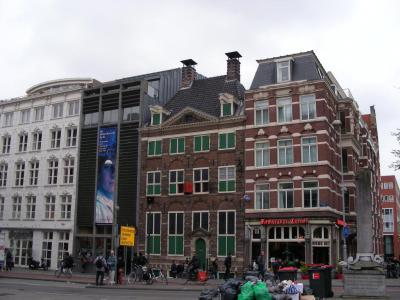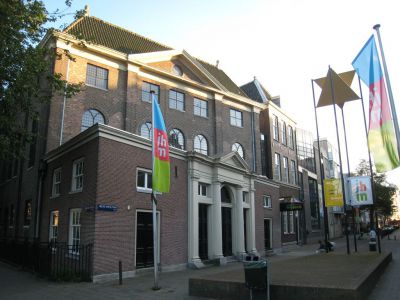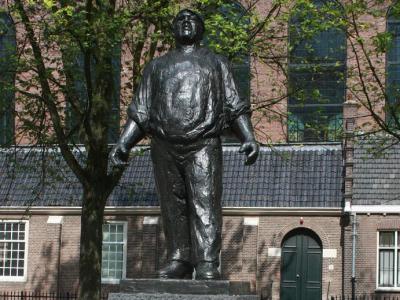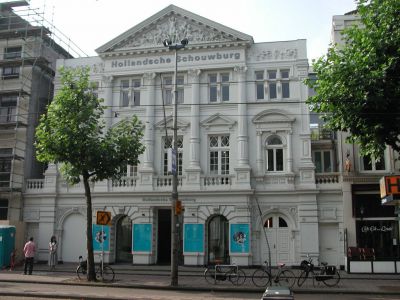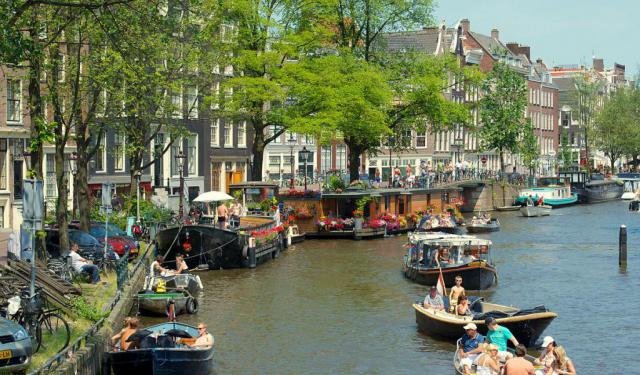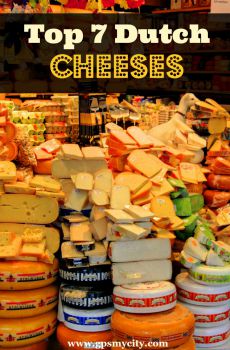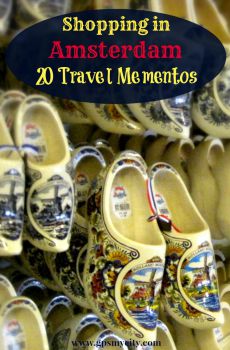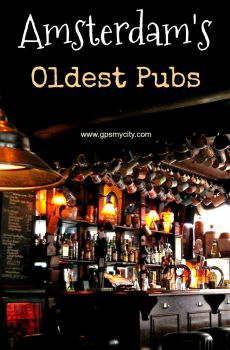
Jewish Quarter Walking Tour (Self Guided), Amsterdam
The Jodenbuurt (Jewish Quarter) of Amsterdam had been the center of the Dutch Jewish community from the 16th century up until the Second World War. The neighborhood is best known as the birthplace of Baruch Spinoza, the home of Rembrandt, and the Jewish ghetto under the Nazi occupation of the Netherlands.
Once crowded with open-air stalls, smoking factories and tenement buildings, the Old Jewish Quarter still retains several moving reminders of the generations of Jews whose succession was brutally broken during the war.
Here are some of the area's famous highlights:
Waterlooplein Flea Market – located in the square named after the Battle of Waterloo;
Rembrandt House Museum – established in a former house in Jodenbreestraat, where between 1639 and 1658, the world-famous Dutch painter, Rembrandt van Rijn, had a studio and art dealership;
Pintohuis (Pinto House) – a former residence of De Pinto, a wealthy Portuguese-Jewish family of merchants and bankers; constructed in 1605;
Gassan Diamonds – an imposing building from 1897, formerly a steam-driven diamond factory;
Uilenburgersjoel – a synagogue in Nieuwe Uilenburgerstraat on the island of Uilenburg, built in the Louis XV style in 1766 for the Ashkenazi Jews;
Portuguese Synagogue – also called Esnoga or Snoge for short, a late 17th-century Sephardic synagogue completed in 1675.
The National Holocaust Museum – located in the former Kweekschool (Reformed Nursery School) at Plantage Middenlaan 27.
To explore these and other key sights in Amsterdam’s Jewish Quarter and reveal the century-long Jewish contribution to the history of the city, take this self-guided walking tour.
Once crowded with open-air stalls, smoking factories and tenement buildings, the Old Jewish Quarter still retains several moving reminders of the generations of Jews whose succession was brutally broken during the war.
Here are some of the area's famous highlights:
Waterlooplein Flea Market – located in the square named after the Battle of Waterloo;
Rembrandt House Museum – established in a former house in Jodenbreestraat, where between 1639 and 1658, the world-famous Dutch painter, Rembrandt van Rijn, had a studio and art dealership;
Pintohuis (Pinto House) – a former residence of De Pinto, a wealthy Portuguese-Jewish family of merchants and bankers; constructed in 1605;
Gassan Diamonds – an imposing building from 1897, formerly a steam-driven diamond factory;
Uilenburgersjoel – a synagogue in Nieuwe Uilenburgerstraat on the island of Uilenburg, built in the Louis XV style in 1766 for the Ashkenazi Jews;
Portuguese Synagogue – also called Esnoga or Snoge for short, a late 17th-century Sephardic synagogue completed in 1675.
The National Holocaust Museum – located in the former Kweekschool (Reformed Nursery School) at Plantage Middenlaan 27.
To explore these and other key sights in Amsterdam’s Jewish Quarter and reveal the century-long Jewish contribution to the history of the city, take this self-guided walking tour.
How it works: Download the app "GPSmyCity: Walks in 1K+ Cities" from Apple App Store or Google Play Store to your mobile phone or tablet. The app turns your mobile device into a personal tour guide and its built-in GPS navigation functions guide you from one tour stop to next. The app works offline, so no data plan is needed when traveling abroad.
Jewish Quarter Walking Tour Map
Guide Name: Jewish Quarter Walking Tour
Guide Location: Netherlands » Amsterdam (See other walking tours in Amsterdam)
Guide Type: Self-guided Walking Tour (Sightseeing)
# of Attractions: 10
Tour Duration: 2 Hour(s)
Travel Distance: 2.0 Km or 1.2 Miles
Author: clare
Sight(s) Featured in This Guide:
Guide Location: Netherlands » Amsterdam (See other walking tours in Amsterdam)
Guide Type: Self-guided Walking Tour (Sightseeing)
# of Attractions: 10
Tour Duration: 2 Hour(s)
Travel Distance: 2.0 Km or 1.2 Miles
Author: clare
Sight(s) Featured in This Guide:
- Waterlooplein Flea Market
- Museum Het Rembrandthuis (Rembrandt House Museum)
- Huis de Pinto (Pinto House)
- Gassan Diamonds
- Uilenburgersjoel (Uilenburger Synagogue)
- Joods Museum (Jewish Museum)
- De Dokwerker (Dockworker Monument)
- Esnoga (Portuguese Synagogue)
- Hollandsche Schouwburg (Holocaust Memorial & Dutch Theater)
- National Holocaust Museum
1) Waterlooplein Flea Market
No visit to a city is truly complete without an exploration of the local bazaar or street market, and Amsterdam's Waterlooplein stands as an unmissable destination in this regard. Among the city's most captivating and historic markets, it offers a diverse array of goods that cater to a wide range of tastes and needs. Whether you're in search of the latest fashion trends, vintage military uniforms, exquisite jewelry, intriguing antiques, or modern electronics, you'll find it all here. Additionally, you can even secure yourself a fantastic deal on a tattoo, as this flea market leaves no stone unturned.
Constructed in the early 19th century, Waterlooplein was once a thriving Jewish market until the Second World War, when the Jewish population was forcibly displaced. Following the war, it was revived and has since become a beloved stopover for both tourists and locals. The market exudes an authentic and rustic bazaar ambiance, offering the opportunity to shop, negotiate prices, or simply peruse the array of merchandise on display.
Please keep in mind that with over 300 stalls to explore, this flea market is not meant for rushed browsing. Given the wide variety of items, making quick decisions can be challenging, so be sure to allocate generous time for your visit.
Why You Should Visit:
Excellent setting for a leisurely afternoon stroll, cultural immersion, and the thrill of discovering hidden treasures, provided you have the inclination and patience.
Tip:
If you're inclined towards saving money, take a preliminary tour of the market before making any purchases. Many items, such as hats and sunglasses, can be found at multiple stalls, with prices varying from one vendor to another.
Constructed in the early 19th century, Waterlooplein was once a thriving Jewish market until the Second World War, when the Jewish population was forcibly displaced. Following the war, it was revived and has since become a beloved stopover for both tourists and locals. The market exudes an authentic and rustic bazaar ambiance, offering the opportunity to shop, negotiate prices, or simply peruse the array of merchandise on display.
Please keep in mind that with over 300 stalls to explore, this flea market is not meant for rushed browsing. Given the wide variety of items, making quick decisions can be challenging, so be sure to allocate generous time for your visit.
Why You Should Visit:
Excellent setting for a leisurely afternoon stroll, cultural immersion, and the thrill of discovering hidden treasures, provided you have the inclination and patience.
Tip:
If you're inclined towards saving money, take a preliminary tour of the market before making any purchases. Many items, such as hats and sunglasses, can be found at multiple stalls, with prices varying from one vendor to another.
2) Museum Het Rembrandthuis (Rembrandt House Museum) (must see)
Rembrandt Harmenszoon van Rijn, commonly known as Rembrandt, stands as a prominent 17th-century painter, rightfully acclaimed as one of the foremost artists of the Dutch Golden Age—a period when the Dutch Empire enjoyed the zenith of its power and renown. Among his myriad talents, Rembrandt excelled as a painter, specializing in portraits, self-portraits, battle scenes, and biblical depictions. Over his lifetime, he crafted an extensive body of work, comprising over 300 pieces, including paintings, sketches, etchings, and drawings.
This charming house, its striking red shutters and ornate facade adorned with intricate wooden shutters and an elaborate pediment, has been meticulously restored to its appearance during Rembrandt's era. It served as the artist's residence during the pinnacle of his fame and popularity, a place where he resided for nearly two decades, crafting some of his most iconic masterpieces, including the magnum opus "The Night Watch." However, the lavish expenditure on furnishings ultimately contributed to his financial downfall. An inventory from that time documents the large collection of paintings, sculptures, and art treasures he had amassed, nearly all of which were seized when he declared bankruptcy and was compelled to relocate to a more modest house in the Jordaan in 1658.
Stepping inside the rooms feels akin to entering one of Rembrandt's own paintings, with quintessential Dutch interiors featuring black-and-white tiled floors, traditional box beds, and works by Rembrandt's contemporaries. Two particularly captivating highlights include the recreation of his studio and a permanent exhibition showcasing his etchings, many of which reveal Rembrandt's empathy for ordinary people, such as beggars and street musicians. Furthermore, the frequent live demonstrations, including paint mixing and print-making, enhance the visit, making it both special and educational.
***JEWISH QUARTER WALKING TOUR***
While Rembrandt was not Jewish himself, his paintings frequently mirror his interactions with the Jewish community in the city, portraying scenes from the Old Testament and featuring numerous faces and figures from Amsterdam's Jewish population.
Why You Should Visit:
A visit here offers a glimpse into Rembrandt's multifaceted life, encompassing his residence, studio, a museum, and valuable insights into the various facets of his existence.
Tip:
Reserve some time to browse the quaint shop located within the museum. You'll discover a selection of delightful, high-quality souvenirs at reasonable prices, making it highly likely that you'll want to acquire something as a keepsake for yourself.
This charming house, its striking red shutters and ornate facade adorned with intricate wooden shutters and an elaborate pediment, has been meticulously restored to its appearance during Rembrandt's era. It served as the artist's residence during the pinnacle of his fame and popularity, a place where he resided for nearly two decades, crafting some of his most iconic masterpieces, including the magnum opus "The Night Watch." However, the lavish expenditure on furnishings ultimately contributed to his financial downfall. An inventory from that time documents the large collection of paintings, sculptures, and art treasures he had amassed, nearly all of which were seized when he declared bankruptcy and was compelled to relocate to a more modest house in the Jordaan in 1658.
Stepping inside the rooms feels akin to entering one of Rembrandt's own paintings, with quintessential Dutch interiors featuring black-and-white tiled floors, traditional box beds, and works by Rembrandt's contemporaries. Two particularly captivating highlights include the recreation of his studio and a permanent exhibition showcasing his etchings, many of which reveal Rembrandt's empathy for ordinary people, such as beggars and street musicians. Furthermore, the frequent live demonstrations, including paint mixing and print-making, enhance the visit, making it both special and educational.
***JEWISH QUARTER WALKING TOUR***
While Rembrandt was not Jewish himself, his paintings frequently mirror his interactions with the Jewish community in the city, portraying scenes from the Old Testament and featuring numerous faces and figures from Amsterdam's Jewish population.
Why You Should Visit:
A visit here offers a glimpse into Rembrandt's multifaceted life, encompassing his residence, studio, a museum, and valuable insights into the various facets of his existence.
Tip:
Reserve some time to browse the quaint shop located within the museum. You'll discover a selection of delightful, high-quality souvenirs at reasonable prices, making it highly likely that you'll want to acquire something as a keepsake for yourself.
3) Huis de Pinto (Pinto House)
While the thoroughfare of Sint Antoniesbreestraat may have felt the relentless pressures of the developers' advances, the resplendent Pinto House stands as a testament to endurance, metamorphosed into a vibrant bastion of communal culture. Distinguished by its off-white Italianate façade, this edifice bears the name of Isaac de Pinto, a Sephardic Jew who, evading the clutches of the Inquisition, embarked on a transformative journey to become a founding figure of the Dutch East India Company.
In the annals of 1651, de Pinto inscribed his legacy by procuring this estate at the extravagant cost of 30,000 guilders, embarking upon an opulent reformation. The outcome was a stately manor characterized by a striking exterior, accentuated by the commanding presence of six towering pilasters, purposefully designed to guide one's gaze skyward toward the ornately embellished balustrade.
De Pinto's residence, a showcase of architectural grandeur, became a subject of fervent discourse, elevated even further when the interior received the artistic caress that mirrored the exterior's majesty. Venture inside and be transported to a realm of opulence, where the original painted ceiling, adorned with avian and cherubic motifs, serves as an awe-inspiring centerpiece. Moreover, a Louis XIV-style fireplace stands sentinel, a paragon of refined craftsmanship, transcending time and kindling an appreciation for a bygone epoch.
In the annals of 1651, de Pinto inscribed his legacy by procuring this estate at the extravagant cost of 30,000 guilders, embarking upon an opulent reformation. The outcome was a stately manor characterized by a striking exterior, accentuated by the commanding presence of six towering pilasters, purposefully designed to guide one's gaze skyward toward the ornately embellished balustrade.
De Pinto's residence, a showcase of architectural grandeur, became a subject of fervent discourse, elevated even further when the interior received the artistic caress that mirrored the exterior's majesty. Venture inside and be transported to a realm of opulence, where the original painted ceiling, adorned with avian and cherubic motifs, serves as an awe-inspiring centerpiece. Moreover, a Louis XIV-style fireplace stands sentinel, a paragon of refined craftsmanship, transcending time and kindling an appreciation for a bygone epoch.
4) Gassan Diamonds
Prior to the cataclysmic outbreak of World War II, a substantial portion of Amsterdam's Jewish population was engaged in the intricate craft of diamond cutting and polishing, a historical facet of the city's heritage. While the diamond industry has somewhat receded from prominence today, one remarkable exception endures in the form of the Gassan Diamonds factory, which occupies a grand and substantial brick edifice dating back to 1897.
Guided tours of this establishment offer a fascinating glimpse into the world of diamond craftsmanship, encompassing visits to the cutting and polishing ateliers, as well as a leisurely exploration of the diamond jewelry showroom, where one may contemplate and, if inclined, acquire a resplendently brilliant yet diminutive keepsake.
Essentially, your visit commences with the issuance of a sticker, ushering you into a 15-minute tour that unveils the artistry of a diamond polisher at work, accompanied by an informative overview of the diamond refinement process. Subsequently, you are afforded the opportunity to convene for an in-depth discussion elucidating the nuances of color and clarity, supplemented by visual aids comprising diamonds ranging from the modestly priced to the truly opulent, with values spanning from €100 to €50,000. To add to the allure, the premises boast an expansive souvenir emporium, replete with an extensive assortment of coveted blue and white delftware.
Guided tours of this establishment offer a fascinating glimpse into the world of diamond craftsmanship, encompassing visits to the cutting and polishing ateliers, as well as a leisurely exploration of the diamond jewelry showroom, where one may contemplate and, if inclined, acquire a resplendently brilliant yet diminutive keepsake.
Essentially, your visit commences with the issuance of a sticker, ushering you into a 15-minute tour that unveils the artistry of a diamond polisher at work, accompanied by an informative overview of the diamond refinement process. Subsequently, you are afforded the opportunity to convene for an in-depth discussion elucidating the nuances of color and clarity, supplemented by visual aids comprising diamonds ranging from the modestly priced to the truly opulent, with values spanning from €100 to €50,000. To add to the allure, the premises boast an expansive souvenir emporium, replete with an extensive assortment of coveted blue and white delftware.
5) Uilenburgersjoel (Uilenburger Synagogue)
The Uilenburger synagogue, an architectural gem in the Louis XV-style (rococo), was originally established in 1766 to host Jewish religious services and faithfully served this purpose for nearly two centuries. It stands as one of the few remaining original structures on the former Uilenburg island. After the Second World War, this historic building underwent diverse uses but has now been entrusted to the Uilenburgersjoel Foundation by the Municipality of Amsterdam.
Established in 2002, the Uilenburgersjoel Foundation was formed with the goal of restoring the synagogue to its Jewish roots and transforming it into a vibrant hub for social and cultural activities involving various Jewish organizations. The vision for the Uilenburgersjoel is to become a center for a wide range of cultural and social activities, including concerts, exhibitions, presentations, Jewish worship, educational programs, and other events aimed at enhancing the well-being of the Jewish community in all its facets.
Furthermore, the facility is well-suited for a range of social and cultural activities catering not only to the general population of Amsterdam but also to the local Uilenburg community. Space within the synagogue will be made available for both regular and occasional users, ensuring its accessibility and utility for a wide array of purposes.
Established in 2002, the Uilenburgersjoel Foundation was formed with the goal of restoring the synagogue to its Jewish roots and transforming it into a vibrant hub for social and cultural activities involving various Jewish organizations. The vision for the Uilenburgersjoel is to become a center for a wide range of cultural and social activities, including concerts, exhibitions, presentations, Jewish worship, educational programs, and other events aimed at enhancing the well-being of the Jewish community in all its facets.
Furthermore, the facility is well-suited for a range of social and cultural activities catering not only to the general population of Amsterdam but also to the local Uilenburg community. Space within the synagogue will be made available for both regular and occasional users, ensuring its accessibility and utility for a wide array of purposes.
6) Joods Museum (Jewish Museum)
Cleverly shoehorned within a remarkable complex featuring four Ashkenazic synagogues dating back to the 17th and 18th centuries, this museum stands as the principal institution in the Jewish Cultural Quarter. It distinguishes itself by placing less emphasis on the Holocaust and instead, delves deeply into all facets of Jewish life and the intricate relationship between the Jewish community and the city of Amsterdam. This museum is truly one of a kind, not only within the country but quite possibly in the entire world, housing an extraordinary collection of rare documents, artifacts, and manuscripts thoughtfully presented within their historical context.
Known as "Mokum" in Hebrew, Amsterdam served as a refuge for Jewish communities for an extended period, welcoming both the Sephardic Jews from the Iberian peninsula and the Ashkenazi Jews from Central and Eastern Europe. Despite sharing the same ethnicity, these two communities existed within distinct economic strata, contributing to the diverse tapestry of Dutch society.
What truly captivates visitors to this museum is its meticulous curation. It offers clear explanations regarding the differences between various Jewish diasporas and how the coexistence of these two groups influenced Dutch society. Additionally, the museum features a faithful reconstruction of a synagogue, providing insights into the beauty of Jewish worship and its integration into daily life. There are also exhibits focusing on the contributions of Jewish individuals to various industries, contrasting their experiences with the impoverished segments of the city's history. In essence, the museum offers a comprehensive experience, complete with a kosher eatery and an excellent bookshop. Moreover, a combined ticket allows access to other notable Jewish sites, including the exquisite Portuguese Synagogue, the evolving Holocaust Museum, and the engaging Children's Museum.
Tip:
If you plan your visit for a Saturday or Sunday, you'll have the opportunity to explore a bustling market in the adjacent square, adding an extra dimension to your weekend excursion.
Known as "Mokum" in Hebrew, Amsterdam served as a refuge for Jewish communities for an extended period, welcoming both the Sephardic Jews from the Iberian peninsula and the Ashkenazi Jews from Central and Eastern Europe. Despite sharing the same ethnicity, these two communities existed within distinct economic strata, contributing to the diverse tapestry of Dutch society.
What truly captivates visitors to this museum is its meticulous curation. It offers clear explanations regarding the differences between various Jewish diasporas and how the coexistence of these two groups influenced Dutch society. Additionally, the museum features a faithful reconstruction of a synagogue, providing insights into the beauty of Jewish worship and its integration into daily life. There are also exhibits focusing on the contributions of Jewish individuals to various industries, contrasting their experiences with the impoverished segments of the city's history. In essence, the museum offers a comprehensive experience, complete with a kosher eatery and an excellent bookshop. Moreover, a combined ticket allows access to other notable Jewish sites, including the exquisite Portuguese Synagogue, the evolving Holocaust Museum, and the engaging Children's Museum.
Tip:
If you plan your visit for a Saturday or Sunday, you'll have the opportunity to explore a bustling market in the adjacent square, adding an extra dimension to your weekend excursion.
7) De Dokwerker (Dockworker Monument)
Positioned prominently on a small square just outside the Portuguese Synagogue, the Dockworker statue, crafted by Dutch sculptor Mari Andriessen, pays tribute to the laborers of Amsterdam, not limited to dockworkers alone. This poignant monument commemorates the courageous actions of the city's workers during February 1941, when they staged a strike in protest of the Nazi treatment of Amsterdam's Jewish population. The catalyst for this historic strike was a series of arrests and violent pogroms instigated by the Germans in the old Jewish quarter of Amsterdam, in retaliation for the injury of several Dutch police officers during a street skirmish.
Regarded as the first public protest against the Nazi regime in occupied Europe, this subsequent strike was orchestrated by the outlawed Communist Party and led by the city's transportation employees and dockworkers. It endured for a remarkable two days, drawing a staggering 300,000 participants to the streets on February 26. On the third day, the German occupiers brutally suppressed the strike, but its memory lives on through an annual observance on February 25. This somber event includes the laying of wreaths and a procession past the Dockworker statue. Notably, representatives from all political parties, along with the city's public transportation authorities and organizations representing Holocaust survivors, partake in this solemn commemoration.
Regarded as the first public protest against the Nazi regime in occupied Europe, this subsequent strike was orchestrated by the outlawed Communist Party and led by the city's transportation employees and dockworkers. It endured for a remarkable two days, drawing a staggering 300,000 participants to the streets on February 26. On the third day, the German occupiers brutally suppressed the strike, but its memory lives on through an annual observance on February 25. This somber event includes the laying of wreaths and a procession past the Dockworker statue. Notably, representatives from all political parties, along with the city's public transportation authorities and organizations representing Holocaust survivors, partake in this solemn commemoration.
8) Esnoga (Portuguese Synagogue)
The prospect of enjoying religious freedom is what attracted a significant number of Jews from across Europe to Amsterdam. Over the years, the city has earned a reputation for its tolerance and its commitment to equal rights for individuals of all backgrounds.
The Jewish community first sought refuge in Amsterdam in the late 15th century, escaping persecution in Spain and Portugal to find a haven of religious liberty in the Netherlands. During this period, the Dutch Republic was engaged in a conflict with Spain, prompting the refugees to adopt the moniker "Portuguese Jews" to avoid further complications.
The community thrived, and approximately a century later, in 1665, the majestic Portuguese Synagogue, also known as the Esnoga, was designed in the prevailing Neoclassical fashion popular in the Netherlands at the time, complete with pilasters and a concealed balustrade. Notably, during its construction, it held the distinction of being the largest of its kind worldwide and took inspiration from the architectural magnificence of the Temple of Solomon in Jerusalem.
Remarkably untouched by the passage of time, the edifice stands sentinel over one of Amsterdam's busiest thoroughfares. Its design and interiors have remained virtually unaltered since the 17th century, allowing visitors to bask in the timeless beauty of its antiquities and grand décor. At night, the entire space is illuminated by approximately 1000 candles, eschewing electric lighting.
Why You Should Visit:
To experience the second-oldest continuously used synagogue in Europe.
Admission also grants access to the Jewish Historical Museum across the street.
Tip:
Don't miss exploring the various annexes connected to the main building, including the board room, winter synagogue, baths, office, candle room, mourning room, and rabbinate. Make sure to descend to the treasure chambers, which house exquisite items such as precious 16th-century manuscripts and tapestries adorned with gold thread, among other treasures. You'll also have the opportunity to view books from the oldest Jewish library in the world.
The Jewish community first sought refuge in Amsterdam in the late 15th century, escaping persecution in Spain and Portugal to find a haven of religious liberty in the Netherlands. During this period, the Dutch Republic was engaged in a conflict with Spain, prompting the refugees to adopt the moniker "Portuguese Jews" to avoid further complications.
The community thrived, and approximately a century later, in 1665, the majestic Portuguese Synagogue, also known as the Esnoga, was designed in the prevailing Neoclassical fashion popular in the Netherlands at the time, complete with pilasters and a concealed balustrade. Notably, during its construction, it held the distinction of being the largest of its kind worldwide and took inspiration from the architectural magnificence of the Temple of Solomon in Jerusalem.
Remarkably untouched by the passage of time, the edifice stands sentinel over one of Amsterdam's busiest thoroughfares. Its design and interiors have remained virtually unaltered since the 17th century, allowing visitors to bask in the timeless beauty of its antiquities and grand décor. At night, the entire space is illuminated by approximately 1000 candles, eschewing electric lighting.
Why You Should Visit:
To experience the second-oldest continuously used synagogue in Europe.
Admission also grants access to the Jewish Historical Museum across the street.
Tip:
Don't miss exploring the various annexes connected to the main building, including the board room, winter synagogue, baths, office, candle room, mourning room, and rabbinate. Make sure to descend to the treasure chambers, which house exquisite items such as precious 16th-century manuscripts and tapestries adorned with gold thread, among other treasures. You'll also have the opportunity to view books from the oldest Jewish library in the world.
9) Hollandsche Schouwburg (Holocaust Memorial & Dutch Theater)
Editor's Note: Presently undergoing renovations, the memorial is scheduled to reopen in 2024, coinciding with the opening of the new National Holocaust Museum just across the street.
Originally, De Hollandsche Schouwburg served as a theater where Jewish artists could freely showcase their talents without hindrance. However, in October 1941, the Germans transformed it into an exclusive venue for Jews, marking it as a significant gathering point for Amsterdam's Jewish population before their harrowing deportation during the subsequent summer. Inside, the absence of natural light and the living conditions foreshadowed the grim reality of the camps to which these families would soon be transported.
Following the war, uncertainty surrounded the fate of the building, but ultimately, its facade underwent restoration, and the front section was refurbished. Today, the ground floor features an eternal flame positioned before a solemn list of the deceased; additionally, four short films narrate the theater's history and its tumultuous past. Ascending the stairs, visitors encounter a small exhibit focusing on the theater's pre-war era, while the floor above houses an exceptional exhibition detailing the plight of the city's Jewish community. This comprehensive exhibit includes numerous wartime photographs and poignant film clips.
In stark contrast, the old auditorium at the rear of the building has been preserved as an empty, open-air space with a missing roof. A memorial column made of basalt, set upon a Star of David base, now occupies the spot where the stage once stood—a profoundly mournful monument that serves as a solemn tribute to the unimaginable suffering endured by countless individuals.
Originally, De Hollandsche Schouwburg served as a theater where Jewish artists could freely showcase their talents without hindrance. However, in October 1941, the Germans transformed it into an exclusive venue for Jews, marking it as a significant gathering point for Amsterdam's Jewish population before their harrowing deportation during the subsequent summer. Inside, the absence of natural light and the living conditions foreshadowed the grim reality of the camps to which these families would soon be transported.
Following the war, uncertainty surrounded the fate of the building, but ultimately, its facade underwent restoration, and the front section was refurbished. Today, the ground floor features an eternal flame positioned before a solemn list of the deceased; additionally, four short films narrate the theater's history and its tumultuous past. Ascending the stairs, visitors encounter a small exhibit focusing on the theater's pre-war era, while the floor above houses an exceptional exhibition detailing the plight of the city's Jewish community. This comprehensive exhibit includes numerous wartime photographs and poignant film clips.
In stark contrast, the old auditorium at the rear of the building has been preserved as an empty, open-air space with a missing roof. A memorial column made of basalt, set upon a Star of David base, now occupies the spot where the stage once stood—a profoundly mournful monument that serves as a solemn tribute to the unimaginable suffering endured by countless individuals.
10) National Holocaust Museum
Editor's Note: Currently not in operation, with plans for a reopening in early 2024.
While it is still in the process of development, this museum, located in a former school adjacent to a nursery, holds a significant historical narrative that merits a visit. Its focus lies in shedding light on the experiences of Jewish children, aged up to 12, who were forced to endure the agonizing wait, separated from their parents, before deportation.
In October 1942, following the Nazis' takeover of the nursery, members of the Jewish Council stationed at the deportation site, with assistance from the resistance and the nursery's director, embarked on a daring mission to rescue Jewish children, providing them refuge within the confines of the school. This initiative, though challenging, eventually evolved into a crucial smuggling network.
A visit to the Holocaust Museum is an emotionally charged experience, offering insight into the lives of younger children through the display of their belongings and narratives. The museum also features an exhibition of photographs, many of which were unearthed years after the war in personal collections or antique shops. These photographs and accompanying documents convey the personal stories of numerous individuals, serving as poignant reminders of the more than 104,000 Dutch Jewish lives tragically lost during the war.
Traveler's Tip:
Across the street, you can take some time to visit the National Holocaust Names Memorial, which prominently displays the names of every identified victim of the genocide in the Netherlands on its wall.
While it is still in the process of development, this museum, located in a former school adjacent to a nursery, holds a significant historical narrative that merits a visit. Its focus lies in shedding light on the experiences of Jewish children, aged up to 12, who were forced to endure the agonizing wait, separated from their parents, before deportation.
In October 1942, following the Nazis' takeover of the nursery, members of the Jewish Council stationed at the deportation site, with assistance from the resistance and the nursery's director, embarked on a daring mission to rescue Jewish children, providing them refuge within the confines of the school. This initiative, though challenging, eventually evolved into a crucial smuggling network.
A visit to the Holocaust Museum is an emotionally charged experience, offering insight into the lives of younger children through the display of their belongings and narratives. The museum also features an exhibition of photographs, many of which were unearthed years after the war in personal collections or antique shops. These photographs and accompanying documents convey the personal stories of numerous individuals, serving as poignant reminders of the more than 104,000 Dutch Jewish lives tragically lost during the war.
Traveler's Tip:
Across the street, you can take some time to visit the National Holocaust Names Memorial, which prominently displays the names of every identified victim of the genocide in the Netherlands on its wall.
Walking Tours in Amsterdam, Netherlands
Create Your Own Walk in Amsterdam
Creating your own self-guided walk in Amsterdam is easy and fun. Choose the city attractions that you want to see and a walk route map will be created just for you. You can even set your hotel as the start point of the walk.
Jordaan Walking Tour
The Jordaan district of Amsterdam is a popular neighborhood renowned for its charming, narrow streets, quaint courtyards, and picturesque canals. Replete with beautiful historic houses, many of which have been converted into cozy cafés, trendy boutiques, and art galleries, this district has a distinctive atmosphere that sets it apart from other areas in the city.
The Jordaan was originally... view more
Tour Duration: 1 Hour(s)
Travel Distance: 2.4 Km or 1.5 Miles
The Jordaan was originally... view more
Tour Duration: 1 Hour(s)
Travel Distance: 2.4 Km or 1.5 Miles
Amsterdam's Historical Churches Walking Tour
The history of Amsterdam is deeply intertwined with its religious heritage. The city is home to several historical churches, each with its own unique charm and significance. These religious sites serve as both spiritual centers and architectural treasures that provide insight into the city's past.
Our walk starts in the Central Station area and leads you to visit the eight most prominent... view more
Tour Duration: 2 Hour(s)
Travel Distance: 3.8 Km or 2.4 Miles
Our walk starts in the Central Station area and leads you to visit the eight most prominent... view more
Tour Duration: 2 Hour(s)
Travel Distance: 3.8 Km or 2.4 Miles
Amsterdam Food Tour
Amsterdam's food scene is a delightful fusion of local traditions and global influences. Making your way through the interlocking canals, pretty bridges, and a maze of streets laden with diverse eateries and bars may easily render you hankering for a bite to eat and/or a drink to wash it down with.
The diverse culinary landscape of Amsterdam caters to a wide range of tastes and... view more
Tour Duration: 2 Hour(s)
Travel Distance: 2.6 Km or 1.6 Miles
The diverse culinary landscape of Amsterdam caters to a wide range of tastes and... view more
Tour Duration: 2 Hour(s)
Travel Distance: 2.6 Km or 1.6 Miles
Southern Canal Belt Walking Tour
The Canal District, known as Grachtengordel in Dutch, is a globally renowned example of urban planning and architectural excellence within Amsterdam. This area has remained remarkably well-preserved for over four centuries, celebrated for its charming small bridges, canal crossings, and 17th-century residences. Encircling the Old City Centre in a horseshoe shape, the Canal Ring encompasses three... view more
Tour Duration: 2 Hour(s)
Travel Distance: 3.1 Km or 1.9 Miles
Tour Duration: 2 Hour(s)
Travel Distance: 3.1 Km or 1.9 Miles
Western Canal Belt Walking Tour
Western Canal Belt is a historic neighborhood in Amsterdam that forms part of the larger Canal Ring, a UNESCO World Heritage Site, which comprises a web of concentric canals. The three main canals making up the Western Belt are Herengracht, Keizersgracht, and Prinsengracht. They are lined with beautiful and somewhat bizarre gabled houses that were built by prosperous merchants in the 17th century,... view more
Tour Duration: 2 Hour(s)
Travel Distance: 2.6 Km or 1.6 Miles
Tour Duration: 2 Hour(s)
Travel Distance: 2.6 Km or 1.6 Miles
Amsterdam Introduction Walking Tour
“Dancing to its own beat,” the Dutch capital Amsterdam is famous for its unusual life rhythm that is manifested in the air of canals, coffee shops, and the Red Light District, as well as many other things that altogether draw annually over five million visitors to the city.
A place where “hipness meets history”, Amsterdam emerged in the late 12th century as a small fishing village... view more
Tour Duration: 3 Hour(s)
Travel Distance: 5.1 Km or 3.2 Miles
A place where “hipness meets history”, Amsterdam emerged in the late 12th century as a small fishing village... view more
Tour Duration: 3 Hour(s)
Travel Distance: 5.1 Km or 3.2 Miles
Useful Travel Guides for Planning Your Trip
Bars of De Pijp, Amsterdam
Sitting to the south of the Centrum (city centre) De Pijp area of Amsterdam is a fascinating mixture of trendy urbanites, students, immigrants and Amsterdammers. De Pijp has a long history as the Bohemian part of town, which is reflected in the different cafés of the area. There truly is something...
Top 7 Dutch Cheeses to Try in Amsterdam
Don't mind things turning a bit "cheesy" when in Holland. After all, this small country is renowned for its cheese manufacturing and successfully competes, in terms of cheese exports, with such economic giants as the United States and Germany. Amsterdam alone and its vicinities are...
12 Traditional Dutch Foods You Must Try in Amsterdam
Cool climate, closeness to sea, and sense of adventure have made the Dutch what they are – skillful farmers, industrious seafarers and, generally, people with the taste for life and good hearty meal, whether it comes from the sea they live by or the land they set their feet on. All of this has...
Souvenir Shopping in Amsterdam: 20 Dutch Things To Buy
Tulips, red lights, weed... Other than these, there are plenty of good things to remember Amsterdam by. What's more, you can take home some of them quite legally. Look here to see what to buy in Amsterdam and...
The Oldest and Historic Pubs of Amsterdam
Amsterdam is a stunningly beautiful city, steeped in history, with hidden treasures and fascinating tales practically around every corner. Like all marvelous cities, Amsterdam has its share of dining and drinking establishments from the modern to the ancient. This guide will assist you in exploring...
Dutch Sweets and Pastries
Known primarily for their cheeses, the Dutch have proven just as passionate about their sweets and pastries, many of which have come about as a result of the centuries of colonial past that had infused Holland with Oriental flavors and ingredients. Blended with their own dairy-rich European...
The Most Popular Cities
/ view all

